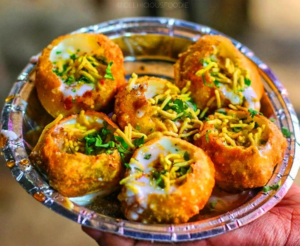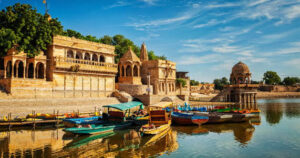Rajasthan’s cuisine is as rich and diverse as its culture and history. Shaped by the harsh desert climate and influenced by the warrior lifestyle of its inhabitants, Rajasthani cuisine is characterized by its use of locally available ingredients, minimal water, and cooking methods that allow food to last for several days. From hearty meat dishes to vegetarian delicacies, from spicy curries to sweet treats, Rajasthani food offers a gastronomic adventure unlike any other. Let’s embark on a culinary journey through this royal state and explore some must-try local dishes.
- Dal Baati Churma
No culinary tour of Rajasthan is complete without tasting its most iconic dish – Dal Baati Churma.
Components:
- Dal: A spicy lentil curry
- Baati: Hard, unleavened wheat rolls
- Churma: Sweetened, crushed wheat balls
Preparation and Serving:
Baatis are traditionally roasted over cowdung cakes, giving them a distinct flavor. They are then dipped in ghee (clarified butter) and served alongside spicy dal and sweet churma. The combination of spicy, sweet, and savory flavors makes this dish a truly unique experience.
Cultural Significance:
Dal Baati Churma originated as a war-time staple. The baatis could be prepared in advance and didn’t spoil easily, making them ideal for long military campaigns.
Where to Try: While available throughout Rajasthan, some of the best Dal Baati Churma can be found in Jaipur at restaurants like Spice Court or Chokhi Dhani.
- Laal Maas
For meat lovers, Laal Maas (Red Meat) is a must-try Rajasthani delicacy.
Ingredients:
- Mutton
- Red chilies
- Garlic, yogurt, and a blend of spices
Preparation:
Tender mutton is slow-cooked with a fiery mix of red chilies and spices, resulting in a deep red curry with a rich, spicy flavor.
Cultural Significance:
Laal Maas was traditionally a hunting dish of the Rajput warriors. The liberal use of chilies helped preserve the meat in the hot desert climate.
Where to Try: Darikhana in Jaipur and Durg Cafe in Jodhpur are known for their excellent Laal Maas.
- Ker Sangri
A vegetarian dish unique to the Thar Desert region of Rajasthan.
Ingredients:
- Ker: A wild berry
- Sangri: Beans from the Khejri tree
- Spices and oil
Preparation:
Ker and sangri are dried and then rehydrated before cooking. They’re then prepared with oil, spices, and sometimes mango powder for a tangy flavor.
Cultural Significance:
This dish showcases Rajasthani ingenuity in creating nutritious meals from the limited vegetation available in the desert.
Where to Try: Many traditional Rajasthani restaurants in Jaisalmer and Bikaner serve authentic Ker Sangri.
- Gatte ki Sabzi
A vegetarian curry made with gram flour dumplings.
Ingredients:
- Gram flour (besan) dumplings
- Yogurt-based curry
- Spices
Preparation:
Gram flour is mixed with spices, shaped into dumplings, and steamed. These dumplings are then cooked in a spicy yogurt-based curry.
Cultural Significance:
This dish is a testament to the creativity of Rajasthani cooks in creating varied dishes with limited ingredients.
Where to Try: Niros in Jaipur is famous for its Gatte ki Sabzi.
- Pyaaz ki Kachori
A popular Rajasthani snack, especially beloved in Jodhpur.
Ingredients:
- Deep-fried pastry
- Spicy onion filling
- Served with tamarind and mint chutneys
Preparation:
A spicy onion mixture is enclosed in pastry dough and deep-fried until golden and crispy.
Cultural Significance:
Kachoris are a popular street food and breakfast item across North India, but the Pyaaz ki Kachori is distinctly Rajasthani.
Where to Try: Janta Sweet Home in Jodhpur is renowned for its Pyaaz ki Kachori.
- Mawa Kachori
A sweet variation of the traditional savory kachori.
Ingredients:
- Deep-fried pastry
- Sweet filling of mawa (reduced milk), dry fruits, and cardamom
Preparation:
A sweet mixture of mawa and dry fruits is enclosed in pastry and deep-fried, then soaked in sugar syrup.
Cultural Significance:
This dish showcases the Rajasthani love for sweets and their creativity in adapting savory dishes into desserts.
Where to Try: Rawat Mishtan Bhandar in Jaipur is famous for its Mawa Kachori.
- Safed Maas
A milder counterpart to Laal Maas, Safed Maas is a creamy, aromatic meat curry.
Ingredients:
- Mutton or lamb
- Cashew nuts, yogurt, cream
- Mild spices like cardamom and coriander
Preparation:
Meat is slow-cooked in a rich, creamy gravy made with cashew paste, yogurt, and mild spices.
Cultural Significance:
This dish was often prepared for royal feasts, showcasing the more refined side of Rajasthani cuisine.
Where to Try: 1135 AD in Jaipur, located within Amber Fort, serves an excellent Safed Maas.
- Bajre ki Roti
A staple flatbread made from pearl millet flour.
Ingredients:
- Pearl millet (bajra) flour
- Water, salt
Preparation:
The dough is rolled out and cooked on a tava (flat griddle), often served with ghee.
Cultural Significance:
Bajra is a drought-resistant crop, making it an important staple in Rajasthan’s arid climate. It’s also highly nutritious.
Where to Try: Any traditional Rajasthani thali meal will typically include Bajre ki Roti.
- Rajasthani Kadhi
A yogurt-based curry distinct from its counterparts in other regions of India.
Ingredients:
- Yogurt
- Gram flour (besan)
- Spices including fenugreek seeds
Preparation:
Yogurt is mixed with gram flour and spices, then slowly simmered to create a thick, tangy curry.
Cultural Significance:
Kadhi is a common dish across North India, but the Rajasthani version is unique in its use of fenugreek and other spices.
Where to Try: Surya Villa in Jaipur is known for its authentic Rajasthani Kadhi.
- Ghevar
A disc-shaped sweet cake associated with the Teej festival.
Ingredients:
- All-purpose flour
- Ghee
- Sugar syrup
- Often topped with mawa or nuts
Preparation:
A batter of flour and ghee is poured into molds and deep-fried, then soaked in sugar syrup.
Cultural Significance:
Ghevar is closely associated with monsoon festivals in Rajasthan, particularly Teej.
Where to Try: LMB (Laxmi Mishthan Bhandar) in Jaipur is famous for its Ghevar.
- Raab
A warming winter drink made from millet flour.
Ingredients:
- Pearl millet (bajra) flour
- Buttermilk or yogurt
- Spices like cumin and ginger
Preparation:
Millet flour is roasted and then cooked with buttermilk and spices to create a thick, soup-like drink.
Cultural Significance:
Raab is valued for its warming properties and is often given to new mothers as it’s believed to increase milk production.
Where to Try: Raab is typically homemade, but some traditional restaurants in Jodhpur and Bikaner may serve it during winter months.
- Mirchi Vada
A popular street food of large green chilies stuffed with spiced potato mixture, battered and deep-fried.
Ingredients:
- Large green chilies
- Spiced potato filling
- Gram flour batter
Preparation:
Chilies are slit, deseeded, stuffed with a spicy potato mixture, dipped in gram flour batter, and deep-fried.
Cultural Significance:
This spicy snack showcases the Rajasthani love for bold flavors.
Where to Try: Janta Sweet Home in Bikaner is renowned for its Mirchi Vada.
- Mohanthal
A rich fudge-like sweet made from gram flour.
Ingredients:
- Gram flour (besan)
- Ghee
- Sugar
- Milk
- Nuts for garnish
Preparation:
Gram flour is roasted in ghee, then mixed with a sugar syrup and milk solids to create a fudge-like consistency.
Cultural Significance:
Mohanthal is often prepared during festivals and special occasions.
Where to Try: Jodhpur Sweet Home in Jodhpur offers excellent Mohanthal.
- Papad ki Sabzi
A unique curry made from crushed papads (poppadoms).
Ingredients:
- Crushed papads
- Yogurt-based curry
- Spices
Preparation:
Papads are crushed and cooked in a spicy yogurt-based gravy.
Cultural Significance:
This dish is a testament to Rajasthani resourcefulness, turning a typically accompanying item into a main dish.
Where to Try: Handi Restaurant in Jaipur serves a good Papad ki Sabzi.
- Malpua
A sweet pancake popular across North India but with a distinct Rajasthani twist.
Ingredients:
- Flour (sometimes with mashed bananas)
- Milk
- Sugar
- Cardamom
- Ghee for frying
Preparation:
A batter is made from flour, milk, and mashed bananas, then fried in ghee and soaked in sugar syrup.
Cultural Significance:
Malpua is often served as prasad (religious offering) in temples, especially during festivals.
Where to Try: Laxmi Mishthan Bhandar (LMB) in Jaipur is famous for its Malpua.
Rajasthani cuisine is a reflection of the state’s history, geography, and culture. The scarcity of water and fresh vegetables led to the development of cooking techniques that could preserve food for several days. The use of milk, buttermilk, and ghee not only added richness to the food but also provided the necessary calories for survival in the harsh desert climate.
The influence of the Rajput warrior culture is evident in the liberal use of ghee and the preference for energy-dense foods. At the same time, the vegetarian traditions of the Marwari community have contributed to a wide array of innovative vegetarian dishes.
When exploring Rajasthani cuisine, you’ll notice some common threads:
- Use of local and long-lasting ingredients: Millet, gram flour, and dried legumes feature prominently.
- Minimal use of water in cooking: Many dishes are dry or have thick gravies.
- Liberal use of ghee and milk products: This adds richness and helps preserve the food.
- Bold flavors: Rajasthani cuisine isn’t afraid of spice, with many dishes featuring a fiery kick.
- Sweet and savory combinations: Many meals combine sweet and savory elements, like the classic Dal Baati Churma.
To truly experience Rajasthani cuisine, consider trying a traditional thali meal. A thali offers a variety of dishes served on a large plate, allowing you to sample multiple flavors in one meal. Many restaurants and hotels in Rajasthan offer special thalis that showcase the best of local cuisine.
When dining in Rajasthan, don’t be surprised if you’re encouraged to eat with your hands. This is a traditional practice believed to enhance the dining experience by engaging all your senses.
Remember that while these dishes are found throughout Rajasthan, each region and even each family may have their own variations. Part of the joy of exploring Rajasthani cuisine is discovering these subtle differences as you travel through the state.
Lastly, while trying local street food can be a great experience, always be mindful of hygiene. Stick to popular vendors with high turnover and opt for freshly cooked, hot foods.
Exploring the cuisine of Rajasthan is not just about satisfying your hunger; it’s about embarking on a sensory journey through the state’s history, culture, and traditions. Each dish tells a story of survival, innovation, and the celebration of life in the desert. So, come with an open mind and an empty stomach, and prepare to be amazed by the flavors of Rajasthan!














